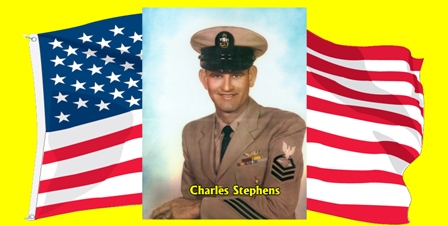|
PROFILE OF A MUSEUM VOLUNTEER Charles W. Stephens, AVCM, USN (Ret), was born May 21, 1932, in Mansfield, Missouri. His family moved to the Fresno area of California in 1937, where he continued to live until joining the U.S. Navy in October 1951. He originally planned to join the U.S. Air Force, but their recruiting office was closed for lunch. On his way out of the building a Navy Chief Petty Officer, standing by the Navy Recruiting office door, beckoned him over and asked if he could have a word with him. A 23 year plus career later, Chuck retired from the U S Naval Service. After boot camp training at San Diego Naval Training Center, Chuck continued on to Naval Air Technical Training Center (NATTC), in Memphis, Tennessee and was trained as an Aviation Machinist Mate. After completing school he was assigned to squadron FASRON 701, located at Naval Air Station (NAS) Miramar, San Diego. While on leave in his hometown, Sanger, CA, en route to his new duty station, he met his future wife. At FASRON 701 Chuck was assigned as assistant plane captain on an AD1 aircraft. During this time he wore out the highway between San Diego and Sanger visiting the future wife. After a period of about 6 months, he was transferred to VF-112, a fighter squadron returning from duty in Korea. After training, he became a plane captain on an F9F-5 aircraft. In June 1953 his squadron deployed aboard the carrier, USS Kearsarge, for duty in the Korean conflict. Upon returning he married Delores Helmuth. They have been married for 45 years, raised two children, and now have three grandchildren. From VF-112 he was assigned to FASRON 12 (the old FASRON 701) for about 3 years shore duty. During this period, at the urging of his wife, he reenlisted for 6 years and requested a change of rate program to the Aviation Electronics Technician rate. He was transferred to NATTC at Memphis, Tennessee for training in the new rate. Upon completing the school, he was assigned to the Photographic Interpretation Center in Washington, DC. It was determined shortly after he arrived that they had no billet for his rate, which was Aviation Electronics Technician First Class, and he was transferred to Naval Air Station Anacostia, Washington, DC. From there he went back to NATTC Memphis for Advanced Electronics School. While there, he took the test for Chief Petty Officer and was selected. He was transferred from NATTC to VAW-11, Airborne Early Warning (AEW) Squadron and began flying as radar operator in the WF2 (Willie Fudd), later named the E1B, and made a cruise on the USS Oriskany. When the E2A turbo prop AEW aircraft came to the fleet, he was trained as radar operator and in-flight maintenance technician for the new aircraft. He later received training and was designated an Air Intercept Controller. He deployed in VAW-11 Detachment "Mike" aboard the USS Enterprise to Vietnam. The detachment was commissioned as VAW-112 during the deployment. He made three cruises to Vietnam aboard the Enterprise—1967, 1968, and 1969. The ship caught fire off Hawaii during the 1969 cruise and was laid up in Pearl Harbor for a couple months for repairs. While assigned to VAW-112 he made ATCS (E8) and was then transferred to Fleet Air Service Operational Training Group Pacific (FASOTRAGRUPAC) NAS North Island, San Diego, for shore duty as Leading Chief Petty Officer of the Electronics Warfare Training course. While there he was selected for Avionics Chief Master (AVCM). His final duty assignment was Maintenance Chief of VA-155, an A7 Attack Squadron at NAS Lemoore, California. He made two partial deployments with VA-155 aboard the USS Oriskany and then transferred to the Fleet Reserve on June 1, 1974. Chuck Stephens first became aware of the Legion of Valor Museum during a visit to the Fresno County Fair where the museum and its volunteers were recognized by one of the shows, a reenactment of World War II Canteen entertainment. He and his wife then visited the museum and were so impressed that they returned a few days later to bring some donations. While there a computer system was donated to the museum, and his wife overheard Chuck Monges' comment to someone that he had no one familiar with the use of computers. Delores spoke up and commented that Chuck knew computers. Knowing Chuck Monges you can imagine what happened next (similar to the Navy Recruiter at the beginning of this story). That was in November 1995, and he continued untill 2003 when Delores became ill enough to need him as her caregiver. Chuck Monges may have recruited him to volunteer initially, but he enjoyed working with the museum and doing all he could to promote US military history. |

